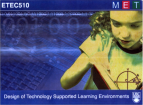Online Design (ETEC 510)
 Design of Technology-Supported Learning Environments (core course)
Design of Technology-Supported Learning Environments (core course)
This course focused on the use of technology to design technology-supported learning environments. My learning in this course included the examination of current research and the application of various media tools as they inform the design of technology-mediated environments. I explored constructivist and sociocultural theories of mind, learning and instruction and their significance for the design of educational technologies and environments.
Artifacts
Written Artifact 1: Instructional Technologies, Media and Methods: An Online Course for Pre-service Teachers
Technology Artifact 2: In this course we worked as a collaborative group to write a research paper on the creation of an online learning environment that incorporates technology. You can view our collaborations through this Google Doc. The final document can be viewed in the Assignment section below.
 Technology Artifact 3: As mentioned in the introduction to this course, part of the learning was to create a technology-supported learning environment. I was preparing to teach an online course at the local university so I welcomed the opportunity to create my first Moodle Shell with a splash page. This course is titled: SCSW 130 Teaching and Learning Strategies and is located in UBC MET Moodle.
Technology Artifact 3: As mentioned in the introduction to this course, part of the learning was to create a technology-supported learning environment. I was preparing to teach an online course at the local university so I welcomed the opportunity to create my first Moodle Shell with a splash page. This course is titled: SCSW 130 Teaching and Learning Strategies and is located in UBC MET Moodle.
Technology Artifact 4:  Another technology-support learning environment that I learned to use in this course was a Wiki in the format of Wikipedia. I had used Wikis before but really liked using the Wikipedia format. My Wiki is titled: Positive Behaviour Interventions and Supports (PBIS) and Response to Intervention (RtI)
Another technology-support learning environment that I learned to use in this course was a Wiki in the format of Wikipedia. I had used Wikis before but really liked using the Wikipedia format. My Wiki is titled: Positive Behaviour Interventions and Supports (PBIS) and Response to Intervention (RtI)
General Reflection:
Technology is everywhere, and I want to assist current and future educators to embrace it as they need to be comfortable with technology if they are to assist students in their learning and future careers. The rapid rate of growth in the field of educational technology and the growth of web-based tools that can be utilized in teaching and learning has provided teachers the ability to incorporate various web-based applications to enhance their teaching and that, in turn, will engage students in their learning.
This course couldn’t possibly cover all of the Web 2.0 tools and applications that exist and be utilized in some manner in the classroom, as that would be impossible to cover in one course. However, being technology pioneers, we wanted to focus our efforts on providing preservice teachers with the introductory skills needed to utilize technology in their teaching practice. The interactivity of the course we created would provide the preservice teacher with a hands-on approach that they can take into their classrooms as they become certified teachers. The 21st century offers teachers many different tools and applications of technology than ever before and to fully grasp this rapid growth, teachers need the skills in order to embrace and utilize this technology in the classroom in order to relate to the digital natives who will be present there.
Working as a collaborative peer development team we believe that we met the goals of our design project as outlined in the Key Frameworks section of our paper. Regarding our first goal, we had conducted a review of literature and reported our findings on the importance and necessity of providing preservice teachers with the necessary skill development in order to integrate technology into their teaching. Further to this, we had documented that preservice teacher programs must include a course on the integration of technology into their undergraduate teacher-training programs in order to address the needs of the digital natives and to have prospective teachers develop skills by which to engage their future students in the learning process. Finally, through our second goal, we had created an online learning environment in which to demonstrate the component skills that we believe, based on our review of literature, are paramount in providing to preservice teachers before they become qualified teachers. We had named our course, Instructional Technologies, Media and Methods (ITMM): A Course for Pre-Service Teachers.
In our ITMM course we had not only added content but we had modeled lesson design together with the use of the technology that we hope preservice teachers would, in turn, make use of in their teaching practice. Throughout our course, preservice teachers would be provided the opportunities to explore innovative and emerging technology resources in authentic learning and teaching situations.
As is the case with teacher education programs, we realized that we would not be able to ensure practicum placements that provide optimal technology integration experiences nor would we have the ability to connect the preservice teacher with a mentor who has the necessary skills in this area. Therefore, with the understanding that some preservice teacher’s practicum placements will be with teachers who are not comfortable using technologies for instructional purposes we believed that it is so important for preservice teachers to gain the skills and practice while in their undergraduate teaching programs that we felt compelled to undertake this design project and create this course.
Reflecting toward the future:
What do I see as the supports that would help me to further cultivate my practice of pioneering leadership?
- This course has moved me light-years ahead in my pioneering! I have now created a number of online courses and absolutely love the creative design work and I think it will be forever a learning experience.
- The supports that I need continue to be the tech departments at both the school district and the university levels where I do my online teaching. However, this course has shown me that the Moodle and Vista online HELP supports are truly worthwhile and invaluable in working out problems in course design.
How does theory learned in this course offer me insights about how I might nurture a change in the culture of my community?
- My biggest hope is that I will be able to create staff modules for use in my school district. These modules would initially be for new hires and would provide them with a thorough induction to the school district, process and procedures and relevant guidelines.
- The next step would be to created our universal Tier 1 inservice through a blended delivery of online and f2f methodologies.
Implementation, surprises, and consequences? Regrets?
- As I related to my colleagues and peers in this course I continue to be amazed at the time it takes to stay on top of a discussion forum. Sounds obvious, but then you create a course that has students working through at their own rate and there are numerous forums for them to discuss various elements of the course, it gets rather crazy – an that’s one course! So I have learned a few valuable lessons in this area by suffering the consequences of creating too many forums. 🙂
- No regrets.
How does this project affect your practice or what new perspectives have you discovered in reflection?
- I’ve learned that students will learn just as much through a few well thought out discussion forums instead of having them discuss every assignment.
- I discovered that some students are rather shy in a discussion forum and that the composition of an on-line class is much the same as a f2f class. I didn’t consider that element before taking this course. Now I will plan accordingly.
- I designed and taught three online courses since taking this particular course. Wow! What great learning! My style is to learn by doing and the combination of teaching and learning at the same time was profound!
Next Steps:
- I am not teaching at the moment but I am slotted to teach a blended course this summer (July) and a fully online course in September.
- My next steps are to complete this eP and spend the next few months perfecting the course modules that I will be delivering.
| Pioneer Trail | ||||
| Bullet Trail |

